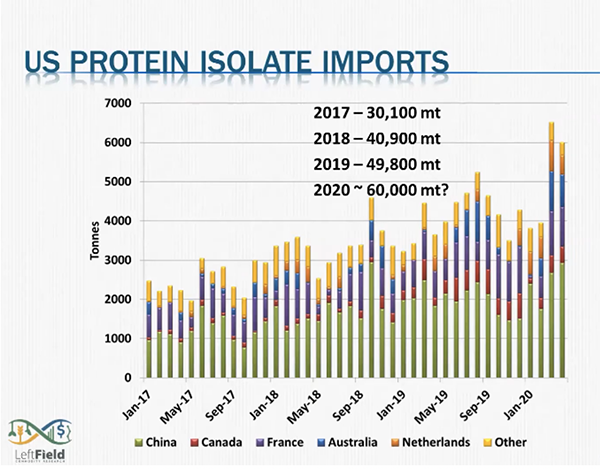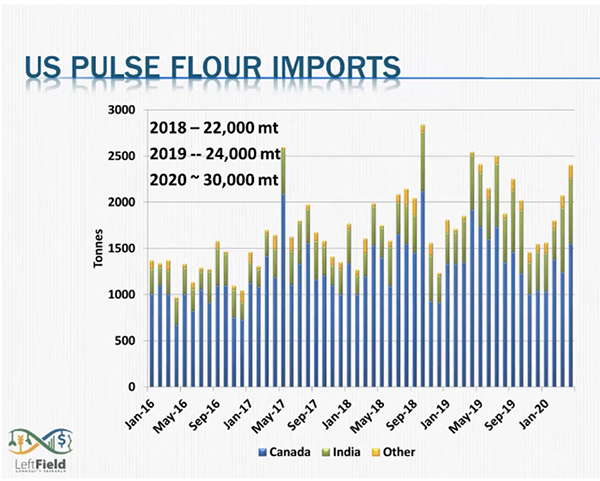July 6, 2020
Last week event organizers created a virtual space for leading experts to share the latest developments in this growing sector


With the logistics of travel and in-person interaction completely upended due to COVID-19, the once novel virtual conference—where speakers and attendees connect from around the world via their computers and other devices—appears to be here to stay.
In the 15th edition of its Plant-Based Foods & Proteins Summit & Exhibition held online last week, the Netherlands-based Bridge2Food Foundation embraced this global trend, showing us that great information-sharing and networking opportunities are still possible without participants having to leave their homes.
This year Bridge2Food employed an innovative online platform to recreate the physical conference experience, one akin to last year’s summit in Saskatoon, Canada, which was the first time it was held in North America. This year, attendees arrived at a virtual check-in desk, where they proceeded to wait in the “lobby” with a live chat window for greeting each other and asking questions before entering “rooms” hosting various presentations and panel discussions. Following each series of sessions, the roughly nine hundred delegates ) in attendance (among them foodservice professionals, retailers, manufacturers, ingredient suppliers and other members of the plant protein sector) had the opportunity to meet with colleagues via 1-on-1 live video chats in the networking carousel.
Staying true to its mission of “advancing and accelerating for a better food world”, Bridge2Food opted to make donations to the Malawi-based non-profit Togetherness Will Enhance Sustainable Actions (TWESA) in lieu of offering gifts to attendees.
“This time we decided, in view of Covid and also poverty, to give a donation for every delegate, which means giving 10 U.S. dollars to TWESA for building a community center where infants will receive food,” said Bridge2Food Founder & CEO, Gerard Klein Essink in his opening remarks. “In Malawi at this moment in time, there is not a lot of work, and when 60% of your income is going to food, you have a food problem.”
The weeklong conference was organized into five daily “tracks” focused on plant-based protein: State of the Pulse Industry & Canadian EcoSystem, Research & Innovation in the Plant Protein Value Chain, New Ingredients & Processing Technologies, New Applications & Formulations, and finally Exhibition & Business Meetings via Live Video Chats. Though billed as a North American summit, the event’s content focused heavily on Canada, which is the world’s top exporter of pulses and is working to create more value-added processing opportunities for these products. Researchers from several prominent Canadian institutions, including the University of Manitoba, University of Saskatchewan and University of Alberta, presented the latest findings and developments in the field of plant protein. Delegates also heard from those focused more on the “front-end” production and marketing side of Canadian crops, including veteran analyst Chuck Penner of Leftfield Commodities.
“I’ve been doing this for about 10 years now, and we’re in a situation where suddenly it seems that pulse proteins are sexy and for some very good reason,” Mr. Penner said to start off his presentation. “That’s been a positive thing for farmers in Canada and elsewhere and for consumers.”

Using his typical, data-driven approach, Mr. Penner presented clear indications of growing imports in plant-based protein isolates and flours, particularly in the U.S, a trend that was echoed throughout the summit. Penner also touched on the different pulse markets, providing overviews and forecasts for lentils, peas, chickpeas, dry beans and fava beans in key areas such as imports, exports, stocks, production, acreage and pricing. Penner closed his presentation with an eye to the future of Canadian pulse processing and continued development of the plant protein market.

“Canadian farmers haven’t yet seen the response or the benefit of having domestic processing simply because those facilities are not yet operational,” he said. “The changing demographics are a powerful force. Climate of course is coming into play, too, but again, we need that ongoing market development. We need the markets for the starch and for the fiber, and a good balance between exports and domestic use is the best outcome so that the market is relying on all kinds of outlets.”
Penner also chimed in on an all-to-brief panel discussion featuring two leading ladies in the world of pulses: Cindy Brown, President of the Global Pulses Confederation (GPC), and Julianne Curran, Vice President of Market Innovation for Pulse Canada. Their comments focused on the many forms of collaboration between the different North American pulse organizations.
“As we look at the thousands of products that have been developed from pulse ingredients, collaboration within the global pulse sector comes back to GPC,” Mrs. Brown mentioned. “And because our association is made up of the entire value chain, we’re a resource for outreach, whether it’s finished products or starting with the raw material.”
Ms. Curran echoed this sentiment in her comments: “We have talked to industry stakeholders about what are the areas where we should be working on together, and the feedback we’ve gotten from them is working collaboratively in that pre-competitive space to continue to build research for pulses and pulse ingredients compared to other more established ingredients like soy protein and whole grains that are much more prevalent in the marketplace and in food products.”
Another champion of this kind of cross-sectoral collaboration, Mr. Essink told us that Bridge2Food hopes to build on the success of last week’s conference in the upcoming 16th Plant-Based Foods & Protein Ingredients Summit Europe 2020, which will take place October 13-15, 2020. The European version of the summit will be hosted by the city of Ede in the heart of the Netherlands, though organizers will be mindful of the potential effects of Covid-19 on international travel to this destination.
When asked what his main takeaways were from the North America summit, Mr. Essink said this: “What surprised me in all the different presentations, if you look at it from a helicopter or bald eagle perspective, you realize how fragmented the value chain is and how much more can be done in plant-based foods, in plant protein ingredients, to connect and to better understand each other and to improve by raising the bar together, and that was at the brand level, at the ingredient level, at the research level, at the ecosystem level. So it’s a very vibrant space, and I find it very positive and inspiring to see.”
“I think in the plant-based industry and dairy and meat there is a big challenge in nutrition and everybody should work there together to get to some kind of standardization which is fair, honest and truthful. Also with methods that are not requiring animal testing of ingredients anymore, which is really outdated. If you don’t do that for cosmetics you can certainly say that you don’t have to prove the nutritional value in an animal. There should be more and different models for that,” he added.

Bridge2Food / Canada / Plant-Based Foods & Proteins Summit & Exhibition / Chuck Penner / Cindy Brown / Gerard Klein Essink
Disclaimer: The opinions or views expressed in this publication are those of the authors or quoted persons. They do not purport to reflect the opinions or views of the Global Pulse Confederation or its members.